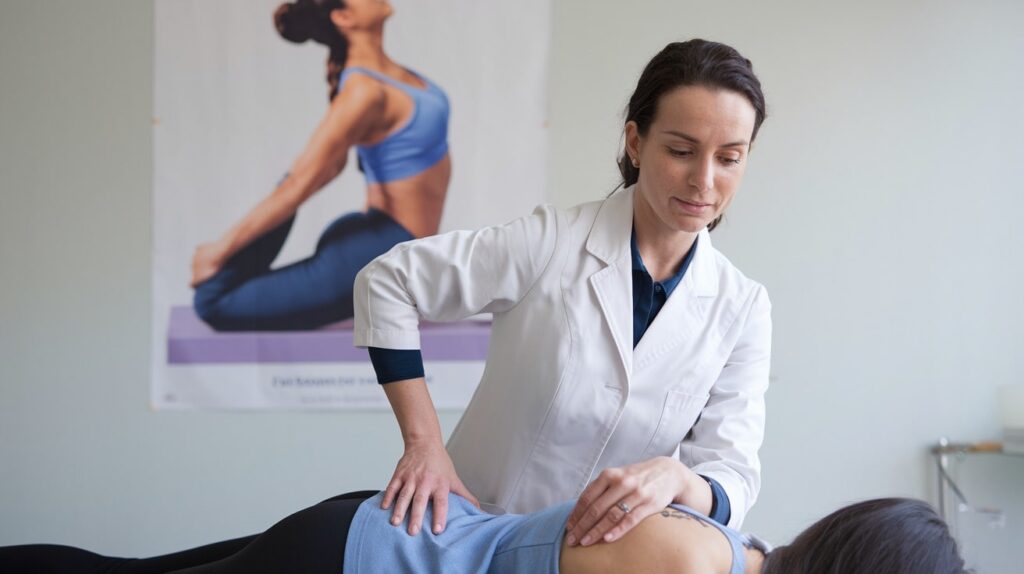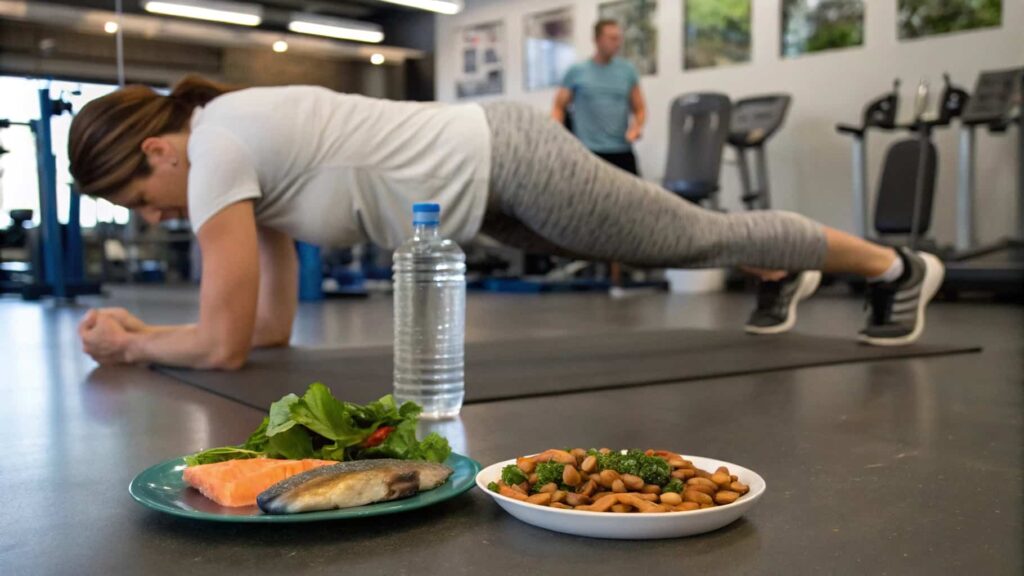Lower back strains are common injuries that don’t just occur during intense activities like deadlifts. One of the most frequent causes of back pain is over-stressing the lumbar muscles during activities involving twisting, bending, or sudden movements. Everyday situations, such as prolonged work in awkward positions, playing games like National Casino for hours, or improperly lifting heavy objects, can easily lead to a lower back strain.
Let’s explore how to accelerate recovery after a lower back strain and take steps to reduce the risk of re-injury in the future.
What Causes A Lower Back Strain?
When the muscles of the lower back are strained, muscle fibers can stretch or tear, and in severe cases, ligaments might also be affected. Symptoms can vary depending on the severity of the injury. A mild strain might result in a dull ache with slight swelling, while a more serious injury could cause intense pain, significant swelling, bruising, and even muscle tears.

To diagnose a lower back strain, it’s important to consult an orthopedic specialist. The doctor may recommend an ultrasound for diagnosis, and in some cases, an MRI or X-ray might be required for more detailed insights.
What To Do For Lower Back Strain?
To relieve pain, reduce swelling, and manage inflammation during a lower back strain, the following methods are recommended:
- Cold Compresses – Apply an ice pack to the affected area for 15 minutes every two hours during the first day to reduce inflammation.
- Warming Ointments – After the first day, use warming creams or ointments to help improve blood flow to the muscles and accelerate recovery.
- Medication – Over-the-counter nonsteroidal anti-inflammatory drugs (NSAIDs) or muscle relaxants prescribed by your doctor can provide pain relief. This treatment should be used for 3–5 days, depending on your doctor’s advice.
- Rest – Avoid movement for 1–2 days to give your muscles time to heal. However, be cautious not to rest for too long, as prolonged immobility can slow down recovery.
Ice Or Heat For Lower Back Strain – Which Is Best?
A common question when dealing with lower back pain is whether to use ice or heat. Both methods can be helpful, but it’s essential to understand when and how to use them.
Ice for Lower Back Strain:
- When to Use: In the first 24-48 hours after the injury. Ice helps reduce swelling and inflammation by constricting blood vessels in the area of injury.
- How to Use: Apply ice packs wrapped in a cloth or towel to the injured area for 15 minutes every two hours during the first day to reduce pain and swelling.
Heat for Lower Back Strain:
- When to Use: After the first 48 hours of the injury, once the inflammation has started to subside. Heat can help relax tight muscles and improve blood flow to the area.
- How to Use: Use a heating pad or warm towel for 15–20 minutes. Do not apply heat to an inflamed or swollen area in the first 48 hours, as it may worsen the inflammation.
What Are The Best Exercises For Lower Back Strain Recovery?
Should I just rest, or should I move? That’s another common concern when dealing with lower back strains. While resting is essential in the initial phase of recovery, completely avoiding movement for too long can cause your muscles to weaken, slow down recovery, and increase the risk of re-injury.

So, what should you do? You need to balance rest with active recovery, which includes gentle stretching and strengthening exercises. This helps improve flexibility, build strength, and promote blood flow to the affected area.
Here are some physical therapy exercises to incorporate once the pain starts to subside:
Twists:
This exercise helps to gently stretch the muscles and improve mobility in the lower back.
- How to Do It: Lie on your back with your knees bent. Place one foot on the floor and rest the other foot on the opposite knee. Place one hand behind your head and the other on the floor. Slowly twist your torso, trying to bring your opposite elbow to your knee. Repeat 15–30 times on each side.
Side Bends:
This stretch helps lengthen the muscles on the sides of your lower back.
- How to Do It: Sit on the floor with your legs extended outward. Bend one knee and place the foot against your opposite thigh. Slowly lean toward the straight leg, reaching for your foot with both hands. Repeat 12–20 times on each side.
“Boat” Pose:
This exercise strengthens the core and helps to stabilize the lower back.
- How to Do It: Lie on your stomach with arms stretched forward. Lift both your arms and legs off the ground simultaneously, keeping your shoulders raised. Hold for 1 minute, then repeat 7–10 times.
Bridge Pose:
This exercise helps strengthen the glutes and lower back muscles.
- How to Do It: Lie on your back with your knees bent and feet flat on the floor. Lift your pelvis, raising most of your back off the ground. Hold for 1–2 minutes, then repeat 5–6 times.
Is Passive Stretching Beneficial For A Lower Back Strain?
While active exercises are important, passive stretching can also help speed up recovery without requiring much effort on your part. For example, using an automatic massage mat can provide effective stretching without putting your back at risk of further injury.
Benefits of Using a Massage Mat:
- Safety – The proper level of pressure ensures that the back muscles are stretched safely without causing strain.
- Comfort – The right pressure will result in a soothing, relaxing stretch, without pain or discomfort.
- Multiple Benefits – Automatic stretching through the mat helps to relieve muscle tension, correct imbalances, improve posture, and reduce the risk of developing spinal issues.
- Convenience – You can use the mat while multitasking. Watch a show, listen to a podcast, or even take a nap while benefiting from the massage.
For the best results, use the massage mat for 15–20 minutes daily, taking a break for 1–2 months after a few weeks of consistent use. Start with a low pressure level (1–3) and gradually increase the intensity as your muscles adapt to the pressure.
How Long Does It Take To Recover From A Lower Back Strain?
The recovery time for a lower back strain can vary depending on how severe the injury is and how well you follow your recovery plan. For mild strains, it may take just a few days to a week to feel better. However, more severe strains can take a few weeks or even months to fully heal. It’s important to listen to your body during this time—if the pain persists or worsens, don’t hesitate to consult with a doctor.
That said, staying consistent with your recovery steps, like using ice and heat therapy and performing gentle exercises, will speed up the healing process. So, be patient, stay active in your recovery, and give your back the time it needs to heal properly.
Additional Tips For Lower Back Strain Recovery – Fast & Effective Healing Tips!

- Hydration and Nutrition: Drinking plenty of water and consuming anti-inflammatory foods like fish, nuts, and leafy greens can support muscle recovery. Avoid processed foods that can increase inflammation.
- Strengthening Exercises for Core Stability: Once the pain subsides, incorporate core strengthening exercises like planks and bird-dogs to help support the lower back and prevent future injuries.
- Posture Awareness: Pay attention to your posture when sitting, standing, and walking to reduce unnecessary strain on your lower back.
- Massage Therapy: Consider professional massage therapy to further relieve muscle tension and improve circulation, helping your muscles heal faster.
By incorporating the right combination of ice, heat, physical therapy exercises, and stretching techniques, you can significantly speed up your recovery from a lower back strain and minimize the risk of re-injury in the future. Always consult a healthcare professional if the pain persists or worsens.
FAQs:
Is surgery ever required for a lower back strain?
In most cases, surgery is not necessary for a lower back strain. Surgery is typically reserved for more serious conditions like herniated discs or spinal stenosis. However, if conservative treatments fail and pain persists, your doctor may discuss surgical options after evaluating your condition.
Can physical therapy help with a lower back strain?
Yes, physical therapy is highly beneficial for strengthening the muscles around your lower back and improving flexibility. A therapist will guide you through exercises tailored to your condition. Physical therapy can help prevent future injuries and speed up the healing process.
What is a lower back strain?
A lower back strain occurs when the muscles or ligaments in the lower back are stretched or torn due to excessive pressure. It typically results from sudden movements, lifting heavy objects, or poor posture. The injury can cause pain, stiffness, and reduced mobility in the affected area.
Can a lower back strain cause sciatica?
Yes, in some cases, a lower back strain can irritate the sciatic nerve, leading to symptoms of sciatica. This typically includes shooting pain, tingling, or numbness that radiates down the legs. If you experience sciatica-like symptoms, it’s important to seek medical attention.
What medications are recommended for a lower back strain?
Over-the-counter medications such as NSAIDs (nonsteroidal anti-inflammatory drugs) can help reduce pain and inflammation. In more severe cases, your doctor may prescribe stronger pain relievers or muscle relaxants to help you manage pain during the recovery process.
Can a massage help with a lower back strain?
Massage therapy can be beneficial for relieving muscle tension and improving circulation in the lower back. It helps relax tight muscles and can provide temporary relief from pain. However, it’s important to avoid deep tissue massage in the acute phase of injury, as it may worsen inflammation.
Final Thoughts:
The best way to ensure that your lower back strain doesn’t return is to follow a consistent recovery plan and make proactive changes to your habits. Focus on strengthening your core, improving your posture, and incorporating stretching exercises into your daily routine. And, if pain persists or gets worse, make sure to consult with a healthcare professional to ensure you’re healing properly.
By using the right combination of ice, heat, physical therapy, and preventive strategies, you’ll be on your way to full recovery and can avoid future lower back injuries.
Also Read:


Leave a Reply